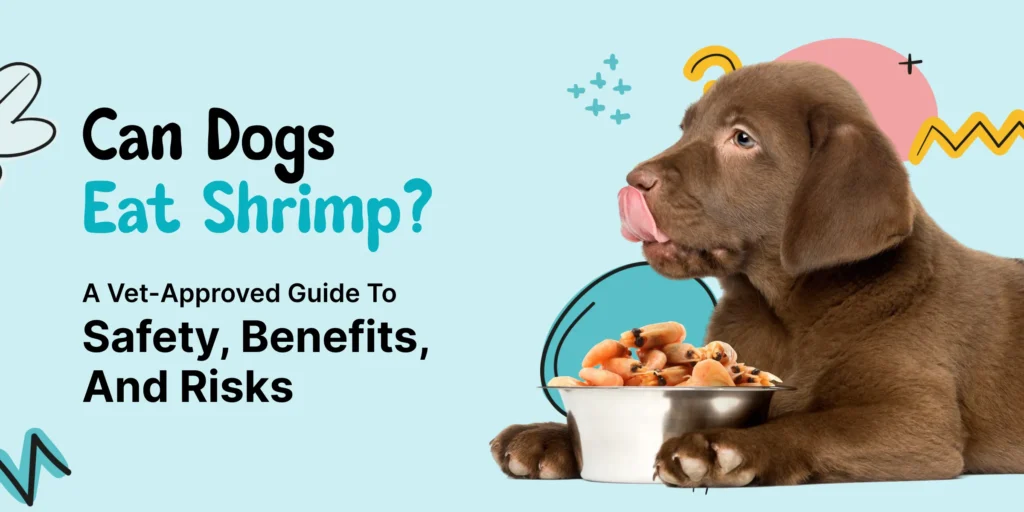Dogs are family members, not just pets; many owners like to spoil them with special treats. If you’ve ever looked at shrimp on your plate and considered giving them to your pet, it’s a wise question to ask. If shrimp is prepared properly and given in modest quantities, it can be safe for dogs. It has vitamins, minerals, and protein that promote health. However, there are crucial considerations. You should avoid anything fried or cooked with salt, butter, or spices since raw shrimp might harbor dangerous bacteria. The shell, tail, and vein should always be removed before giving it to your dog. Without any additional ingredients, boiling or steaming the shrimp is the safest way to prepare them. To observe how your dog responds, start with a tiny amount. They shouldn’t eat shrimp every day; they should only eat it occasionally. For a little dog, half a shrimp is sufficient, and for a larger dog, one to two pieces. After giving a new diet, always keep an eye out for any odd symptoms, and if in doubt, consult a veterinarian. Shrimp can be a tasty and nutritious food for your dog if it is prepared properly.
Can Dogs Eat Shrimp?
Yes, dogs can eat shrimp as long as it is properly prepared and in moderation. It must be simple, like no preparing meals, butter, or spices, and the shell, tail, and vein should be cut off. Dogs shouldn’t eat shrimp every day; they should only have it as a treat occasionally. It can be a
healthy and safe snack if made properly.
| Condition | Safety Status | Notes |
|---|---|---|
| Cooked, Plain | Generally Safe | Shrimp must be fully cooked with no spices, oil, or butter. |
| Raw | Unsafe | May have harmful bacteria or parasites that can make dogs sick. |
| With Shell/Tail | Unsafe | It can cause choking or block the stomach or intestines. |
| Seasoned/Battered | Unsafe | Spices (especially garlic or onion) and fats are harmful to dogs. |
| In Small Portions | Safe (as a treat) | Only give a little; too much can lead to high cholesterol or sodium. |
Nutritional Benefits of Shrimp for Dogs
- Shrimp is a good source of protein, which helps build strong muscles.
- It contains vitamin B12, which supports healthy brain and nerve function.
- Shrimp has vitamin D, which helps keep bones strong.
- It provides minerals like selenium, which act as antioxidants to protect the
body. - Shrimp is low in calories, making it a healthy treat option in small amounts.
| Nutrient | Benefit for Dogs |
|---|---|
| Protein | Protein helps build and repair muscles, tissues, and organs. It supports overall growth, a strong immune system, and the production of important enzymes and hormones. |
| Vitamin B12 | Vitamin B12 supports a healthy nervous system and brain function. It also helps produce red blood cells and converts food into energy. |
| Niacin | Niacin helps convert food into energy, supports healthy digestion, skin, and coat, and plays a role in nerve function and maintaining a balanced metabolism. |
| Phosphorus | Phosphorus works with calcium to build strong bones and teeth. It is also important for energy storage, muscle movement, and tissue repair. |
| Selenium | Selenium acts as an antioxidant to protect cells from damage. It supports the immune system and helps regulate thyroid function and metabolism. |
Potential Risks of Feeding Shrimp to Dogs
Dogs can enjoy shrimp as a treat, but it must be provided with caution. It can cause allergies, choking, upset stomachs, and health problems from too much salt and cholesterol if it is not cooked properly or consumed in excess. Additionally, raw shrimp may harbor dangerous
bacteria. These dangers and methods to keep your dog safe are described in the table below.
| Risk | Explanation | How to Avoid or Reduce the Risk |
|---|---|---|
| Allergic Reactions | Some dogs may be allergic to shrimp, causing itching, hives, or vomiting, although this is rare. | Start with a very small piece and watch your dog closely for any signs of allergy. |
| Choking Hazard | Shrimp shells, tails, or large pieces can cause choking or block the digestive tract. | Always remove shells, tails, and heads. Cut shrimp into small, bite-sized pieces. |
| Digestive Upset | Fatty shrimp, shells, or too much shrimp can cause vomiting or diarrhea. | Feed only plain, cooked shrimp in small amounts and as an occasional treat. |
| High Cholesterol/Sodium | Giving shrimp often or in large amounts may lead to health problems related to cholesterol and salt. | Offer shrimp only rarely and in moderation, not as a regular part of the diet. |
| Foodborne Illness/Parasites | Raw shrimp can carry bacteria like Salmonella or parasites that can make dogs sick. | Always feed shrimp fully cooked; never feed raw shrimp. |
How to Safely Prepare Shrimp for Your Dog
When cooked properly, shrimp can be a safe and nutritious treat for your dog. Use this easy, step-by-step method to ensure that you are serving shrimp in a safe manner. Every action matters to keep your dog safe and provide them the greatest experience.
| Preparation Steps | Instructions | Why It’s Important |
|---|---|---|
| Choose the Right Shrimp | Select fresh or frozen raw shrimp that are plain and unseasoned. Avoid pre-cooked, breaded, or flavored shrimp. | This ensures there are no hidden ingredients like salt, spices, or sauces that can be harmful to dogs. |
| Cook Thoroughly | Boil, steam, or grill the shrimp until they become pink, firm, and fully opaque. Never feed raw shrimp. | Cooking kills harmful bacteria and parasites, such as Salmonella or Vibrio, that may be present in raw shrimp. |
| Remove Everything | Peel off the shell, tail, and head completely. Also, remove the dark vein running along the back of the shrimp. | Shells and tails can cause choking or digestive issues. The vein may contain dirt or bacteria. |
| Avoid Additives | Do not add oil, butter, salt, garlic, onion, or any seasonings while cooking or serving. | Many seasonings and fats used in human food are toxic or too rich for dogs and can cause health problems. |
| Cut into Small Pieces | After cooking and cleaning, chop the shrimp into small, bite-sized pieces appropriate for your dog’s size. | Cutting reduces the risk of choking, especially for small dogs or dogs that eat quickly. |
Shrimp is a healthy and tasty treat for your dog if you properly follow all the instructions. After
feeding, keep an eye out for any signs of discomfort or allergies in your dog and always offer
in moderation.
How Much Shrimp Can a Dog Eat? (Portion Size & Moderation)
In moderation and occasionally, shrimp can be a nutritious treat for dogs. Your dog’s regular diet shouldn’t be replaced by it. Protein and vitamins are good components found in shrimp, but if your dog consumes too much of it, the cholesterol and sodium might be dangerous. Because of this, shrimp should only be served as a special treat once or twice a month.
The size of your dog determines the appropriate amount. Half to one tiny shrimp can be consumed by a small dog (under 20 pounds). One or two shrimp can be fed to a medium-sized dog (20 to 50 pounds). Up to three shrimp may be consumed by a large dog (over fifty pounds).
Make sure to serve shrimp that are thoroughly cooked, without any added salt, butter, or spices, and with the shell and tail removed. To prevent swallowing, cut it into little pieces. Once your dog has eaten, keep an eye out for any indications of digestive problems or allergies. Consult your veterinarian before providing shrimp to your dog if they have any health concerns.
| Dog Size | Suggested Serving (As an Occasional Treat) |
|---|---|
| Small (under 20 lbs) | ½ to 1 small shrimp |
| Medium (20–50 lbs) | 1 to 2 small or medium shrimp |
| Large (over 50 lbs) | 2 to 3 medium or large shrimp |
Only give shrimp once or twice a month. That’s what we mean by “occasionally.” Shrimp and
other treats should make up no more than 10% of your dog’s total daily food. The rest should
come from their regular, balanced dog food.
Signs Your Dog Has Eaten Too Much or Is Having a Reaction
After providing your dog with shrimp, it’s important to keep an eye out for any indications that your dog may be experiencing difficulties. While some reactions may be moderate and treatable at home, others may be more dangerous and require prompt veterinarian attention. Keeping your dog safe and healthy can be achieved by knowing what to look for and what to do. Your dog may have an upset stomach, an allergy, or have eaten too much shrimp if they throw up or have diarrhea.
It is important to keep an eye on these symptoms and seek veterinary care if they develop or persist. Itching or scratching, particularly when accompanied by a rash, may be a sign of an allergic reaction. A severe allergic reaction is indicated by swelling in places like the face or paws, which calls for immediate veterinarian attention. Choking or having trouble breathing is an emergency that requires quick care.
Finally, if your dog becomes weary or loses their appetite, it may indicate a blockage or digestive issue. If this persists for more than a day, a veterinarian should be consulted. Always follow your instincts; if your dog seems off, it’s best to be safe and get professional help.
| Symptom | Possible Cause | What the Symptom Means | What You Should Do |
|---|---|---|---|
| Vomiting | Eating too much shrimp, an upset stomach, allergy. | Your dog’s stomach may be upset, or it could be an allergic reaction. | Watch your dog closely. If vomiting happens more than once or lasts a long time, take your dog to the vet. |
| Diarrhea | Overeating shrimp, digestive upset and allergy. | The digestive system is irritated or reacting to shrimp. | Make sure your dog drinks plenty of water. If diarrhea is severe, lasts more than a day, or your dog seems weak, see the vet. |
| Itching or Scratching | Allergic reaction | Your dog might be allergic to shrimp. | Watch carefully for signs like red skin or hives. If itching is severe or your dog has rashes or hives, contact your vet quickly. |
| Swelling (face, paws, mouth) | Severe allergic reaction | This is a serious reaction that can block breathing or cause pain. | Take your dog to the vet or emergency animal hospital immediately. This is an emergency. |
| Difficulty Breathing or Choking | Severe allergic reaction or life-threatening allergic reaction | Your dog may be choking or having a blocked airway. | Seek emergency veterinary care right away. Try to check if something is stuck in the throat and remove any obstruction if possible. |
| Loss of Appetite or Lethargy | Stomach upset, possible digestive blockage | Your dog feels sick, or something may be stuck in their digestive system. | Watch your dog closely. If this lasts more than 24 hours or your dog becomes very weak, take them to the vet. |
What About Shrimp Shells, Tails, or Raw Shrimp?
Although small amounts of cooked, basic shrimp can be a safe treat for dogs, various preparations and components of the shrimp are unsafe. Dog owners frequently question whether to feed their pets raw shrimp, shells, or tails, but these can be dangerous. The hardness and sharpness of shells, tails, and heads might injure your dog’s digestive tract or cause choking.
Additionally, eating raw shrimp puts you at risk for acquiring parasites or dangerous bacteria. Even processed or freeze-dried shrimp goods need to be closely inspected for dangerous components like seasoning or additional salt. When used according to the directions on the packaging, a product that is specifically designed for dogs, such as dog food that contains shrimp, is usually safe.
| Shrimp Parts/Types | Safety Status | Reasons |
|---|---|---|
| Shrimp Shells | Unsafe | Shells are tough, sharp, and not digestible. They can cause choking or internal cuts in the mouth, throat, or intestines. |
| Shrimp Tails | Unsafe | Tails pose a choking hazard, especially for small dogs. They are also difficult to digest. |
| Shrimp Heads | Unsafe | Shrimp heads contain sharp parts and digestive organs, which can carry toxins or bacteria. |
| Raw Shrimp | Unsafe | Raw shrimp may carry bacteria like Salmonella or E. coli and parasites that can cause illness in dogs. |
| Freeze-Dried Shrimp | Potentially Safe | It can be safe if plain, with no added salt, garlic, or seasoning. Check the ingredient list carefully. Give only as a rare treat. |
| Shrimp Dog Food | Generally Safe | Specially made for dogs, with balanced nutrients and no harmful additives. Follow the portion instructions on the label. |
KEY TIPS
- Always remove the shell, tail, and head before feeding shrimp to your dog
- Never serve raw or seasoned shrimp
- If using store-bought shrimp treats, read the label to avoid additives
- When in doubt, consult your vet, especially if your dog has allergies or digestive issues
Alternatives to Shrimp
There are several safe and healthful alternatives if your dog isn’t an advocate of shrimp for whatever reason, like allergies, safety concerns, or personal preference. When prepared properly, many common foods can be turned into delicious dog treats. The secret is to select safe, easy-to-digest, natural, and unseasoned foods for dogs. Professional snacks created especially for dogs that have been approved by veterinarians are also available. New treats should always be introduced gradually, and any odd reactions should be observed.
| Safe Treat Option | Why It’s a Good Choice | Preparation Tips |
|---|---|---|
| Cooked, Plain Chicken | Great source of lean protein that supports muscles and energy. Easy to digest for most dogs. | Boil or bake without spices. Remove all bones, skin, salt, and oil before serving. |
| Cooked, Plain Turkey | Another healthy, lean meat option. Helps keep dogs full and supports strong muscles. | Only give plain, unseasoned meat. No bones, skin, or leftovers from seasoned dishes. |
| Plain Green Beans | Very low in calories and high in fibre. Good for weight management and digestion. | Serve raw, steamed, or boiled. Avoid canned beans with added salt or preservatives. |
| Carrots | Crunchy and rich in vitamin A. Helps clean teeth and is safe for dogs to chew on. | Give raw or cooked. Slice into bite-sized pieces to avoid choking. |
| Blueberries | Full of antioxidants that support brain and heart health. Also, a tasty, low-calorie treat. | Offer fresh or frozen, plain with no sugar or toppings. Great as small training rewards. |
| Commercial Dog Treats | Convenient and made specifically for dogs’ needs. Often balanced with nutrients dogs require. | Choose vet-recommended, high-quality treats. Avoid treats with artificial flavors or fillers. |
Important Tips
- Always introduce new foods slowly and one at a time.
- Watch your dog for any signs of allergies or digestive upset.
- Treats should only make up 10% or less of your dog’s daily food
When to Consult Your Vet
Although many dogs enjoy shrimp as a treat, it’s crucial to keep an eye out for any indications that your dog may be experiencing issues. Particularly if the shrimp isn’t prepared properly or is given too frequently, some dogs may experience allergic reactions or stomach problems. Here are some times to call your veterinarian to ensure your dog’s safety and well-being:
| Safe Treat Option | Situations | Recommendations |
|---|---|---|
| Suspected severe allergic reaction | Your dog may be experiencing a life-threatening emergency if they exhibit symptoms like facial or paw swelling, have trouble breathing, or collapse. | Your dog needs to see a veterinarian or emergency clinic immediately. |
| Persistent vomiting or diarrhea | If your dog vomits or has diarrhea more than once, or symptoms last longer than 24 hours. | Contact your veterinarian as dehydration may result, requiring medical attention. |
| Signs of pain or discomfort after eating | Your dog is restless, whining, hunched, or refusing food after eating shrimp. | Make an appointment with a veterinarian; this could indicate shrimp irritation or stomach upset. |
| Concern about choking or blockage | Your dog is coughing, gagging, choking, or refusing food. | This could indicate a blockage; take your dog to the veterinarian immediately. |
| Underlying health conditions | Your dog has kidney disease, heart problems, or known allergies. | Consult your veterinarian before offering shrimp or any new treat. |
| Unsure about portion size | Overeating shrimp may cause health issues due to high cholesterol and sodium. | Consult your veterinarian for safe serving size based on your dog’s size, age, and health. |
| General doubts or questions | You are unsure whether shrimp is safe or how to serve it. | Ask your veterinarian for personalized guidance on feeding shrimp to your dog. |
Shrimp Safety Checklist for Dog Owners
- Make sure the shrimp is fully cooked by boiling, steaming, or grilling. Never give raw shrimp because it can have harmful bacteria or parasites.
- Use plain shrimp with no seasonings, sauces, butter, or oils, as these can be harmful or toxic to dogs.
- Remove all shells, tails, and heads from the shrimp to prevent choking or injury to your dog’s digestive system.
- Cut the shrimp into small, bite-sized pieces so your dog can chew and swallow easily, especially if your dog is small.
- Give only a small amount of shrimp to avoid stomach problems and reduce risks from cholesterol and sodium.
- Feed shrimp only as an occasional treat, not every day, to keep your dog healthy.
- Watch your dog carefully after feeding shrimp for signs like itching, vomiting, diarrhea, or swelling, and contact your vet if any problems appear.
When I want to give shrimp to my dog, I always follow some important safety steps. First, I start to cook the shrimp until they become pink, since raw shrimp can make dogs sick. Since spice, butter, and oil can be detrimental to my dog, I make sure the shrimp is basic. To prevent choking, I carefully take off the head, tail, and shell before giving it to my dog. To make it easier for my dog to eat, I then chopped the shrimp into little pieces. I treat it as an occasional snack rather than something I provide every day, and I only give a small amount at a time. After my dog eats the shrimp, I watch closely for any signs of problems like itching, vomiting, or diarrhea. If I see anything unusual, I call the vet right away to keep my dog safe.
How to Prep Shrimp for Paws
- Start with plain, raw shrimp without any spices, sauces, or breading.
- Cook the shrimp by boiling or steaming until they turn pink and white.
- Remove the shell, tail, and head completely after cooking.
- Cut the shrimp into small, bite-sized pieces for safe eating.
Conclusions:
When given infrequently, plain, cooked shrimp can be a safe and healthful treat for dogs. But it’s important to correctly prepare the shrimp, making sure it’s cooked through, plain, and cut into little pieces. You should also feed it in moderation. After giving your dog shrimp, always keep an eye on them and consult a veterinarian if you observe any strange reactions or if you have any worries.




